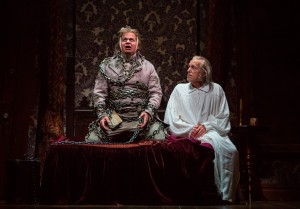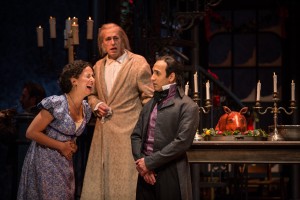DUMBING DOWN DICKENS
It doesn’t matter that A Christmas Carol has drifted from Dickens: Goodman Theatre will never slaughter its sacred (cash) cow. For 38 years now, playing three venues and employing 10 directors, 32 Tiny Tims and 8 Ebenezer Scrooges (making 23,000 “Bah humbugs!”), Chicago’s biggest regional theater has doggedly transformed Charles Dickens’ 80-page 1843 parable into a two-hour holiday tradition. A commercial chestnut, this sprawling spectacle delivers a glorious pageant’”costumes, carols, period-perfect decors’”stuffed with a story too comfortingly familiar to take seriously.
That’s the coal in Goodman’s splendid stocking. A glib complacency has seeped into the show. Not only is there no doubt that Marley was dead as a doornail, there’s no question that Scrooge will be saved at the end. From the start Ebie comes off as an endearing, penny-pinching skinflint, a curmudgeonly crank with intimacy issues. We just know the lovable loser will see the light (with the help of some spirit therapy). It doesn’t matter that Dickens conceived him or Victorian readers feared him as a miserable miser who damned the world and, even worse, dammed the flow of money. Scrooge was a usurious bogeyman and misanthrope, a taker with no give, just get. In 1692 Salem he’d have been hanged.
That was then. This is now: Twinkling, simpering and winking, Larry Yando’s Ebenezer Scrooge manages to miss the essential elements of this character: His Scrooge seldom seems threatening and he only pretends to be scared. Instead we get slapstick shtick throughout, never more so than in the final scene’”tediously bad vaudeville’”in which he tricks Bob Cratchit (Ron E. Rains) into thinking he’s his old unredeemed self. He’s still using people, just in a different way. Yando constantly mugs double takes a la Benny Hill. Throughout the codger’s all-night journey’”to his past, then into the present and a frightening future’”this splenetic Scrooge is merely petulant and pouty. He’s ever so irritated that his Christmas Eve slumber has been disturbed by three very loud Ghosts (Marley is one too) and one very quiet one. In this safe version, Scrooge gives in to goodness because it’s too much trouble to play the heavy.
More than a concoction of a confection, Tom Creamer’s faithful script has actually grown darker over the last few seasons. To his credit Creamer has slowly replaced the tinsel trappings with the hard-luck details of the characters’ poverty. But, given these 38 stagings, it may be too late: For nearly two generations audiences have gorged on melodramatic sentiment, stylized and hammy histrionics, Grand Guignol horror effects, and farcical pantomime. The result under Henry Wishcamper’s direction: Condescending chuckles’”from start to finish’”vastly outweigh the shocks of recognition. Carol serves an intoxicating recipe–the collective denial that Scrooge could ever be us, exacerbated by the wishful thinking of Americans on an amusement ride. It’s a bad brew.
The biggest lost opportunity in 2015’s production is the first ghost. Marley’s terrifying visit is where Dickens drives home the truth that Scrooge will learn or die alone: We’re “fellow passengers to the grave” who must find common cause’”and dispense charity, not prisons and workhouses’”because of that mortality. The insect on the leaf must not disdain his brothers on the ground. Unfortunately, Joe Foust’s Marley is more about making a dramatic entrance than effecting an intervention. Bellowing almost incoherently, he hectors Scrooge–and loses the audience. There’s no ravaging regret over wasted opportunities, just deafening overkill. It’s altogether too “flowery,” as Scrooge sardonically puts it–and many in the audience laughingly agree. Better to go through the motions, falling back on the master’s reliable whimsy and downplay this downer of a Dickens.
Given how short his saga really is, Scrooge has very little time to earn his salvation. And it’s hard to believe this Scrooge really is reformed, not when a post-spirit Yando is so grotesquely delighted to terrify his housekeeper. (He’s been scaring people all his life. Enough already!) If you go by the surface, sure, Scrooge looks saved. But to go from one extreme–an almost pathological parsimony–to the other–a manic and unsustainable extroversion–makes this second Scrooge seem a trick of the stage light. The truth is in between.
In the ideal Christmas Carol (which just happens to be the 1951 film version with Alastair Sim), Scrooge is too real to be funny. He’s not amusing until he too is amused. When the joke’s on him, it’s also on us. Ho, ho, no!
Other than a complete retooling, there’s no silver mistletoe to cure this Dickens Lite. Goodman’s goal should be a retelling that, at least for a first viewer (like a child), constantly leaves the end in doubt. There’s way too little at stake here, and the crowd is too smugly satisfied at their superiority to Scrooge. Goodman’s cash cow needs a heart to match its udders.
photos by Liz Lauren
A Christmas Carol
Goodman Theatre
Albert Theatre, 170 North Dearborn
scheduled to end on December 27, 2015
for tickets, call 312.443.3800 or visit Goodman Theatre
for info on other Chicago Theater, visit Theatre in Chicago











{ 1 comment… read it below or add one }
I saw the most poignant Christmas Carol at the Quest Theatre last weekend. Even though a musical, with it’s moments of light-heartedness the transformation of Scrooge appeared to be genuine, not melodramatic. The cast was top-notch. And to top it all off the show was FREE (as was the parking). It doesn’t have all the bells and whistles of the Goodman, but it does have heart and warmth and some PUPPETS too!